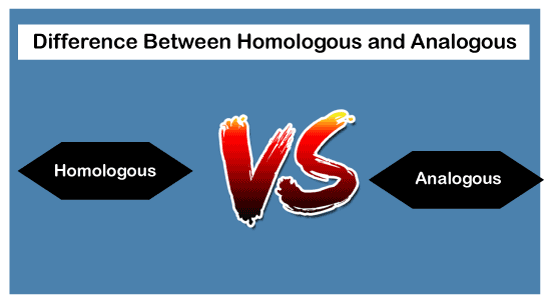Difference between Homologous and AnalogousBiology is a vivid subject covering various parts of the human body. Biology gives explanations regarding the working of the systems in the body. We have heard many terms like homozygous, heterozygous, the nervous system, respiratory system, etc. There are several terms that we study in biology. But today, we will be discussing about two significant terms, i.e., homologous and analogous. We might not have studied them, but they hold importance in biology. So, without further ado, let us begin by knowing the primary meaning of these homologous and analogous. HomologousHomologous or homology is a distinctive term in biology. Homologous is defined as the similarity in physiology and structure of an organism. In this condition, the development of various species takes place with common ancestors, i.e., the ancestors of a particular organism are the same. The homologous is categorized into three significant categories, namely developmental homology, molecular homology, and structural homology. The major characteristic of homologous is that the organism has evolved from a common ancestor. The term homologous first came into being in the year 1859. Many researchers and scientists like Geoffroy, Richard Owen, Darwin used the term. One of the common examples of homologous can be dogs and crocodiles because they have evolved from tetrapod structures (ancestors). 
AnalogousAnalogous is also called analogy in biology. Analogous is defined as the organisms that perform the same functions. The analogous organisms have different evolutionary ancestors. One of the most common examples of analogous organisms is the wings of birds and insects. They might seem to be different, but they have the same ancestors. There are four main types of analogous, i.e., opposite analogy, object and classification analogy, object and related analogy, cause and effect analogy, etc. There are several other types of analogies that we will be discussing later. Now, let us take a look at some of the fundamental differences between homologous and analogous.
So, these are some of the primary differences between homologous and analogous organisms. It is important to note that the defining difference between homologous and analogous organisms is the ancestral evolution, i.e., homologous organisms have the same ancestors, unlike analogous organisms. Now, there are several types of analogous and homologous. So, let us discuss them briefly. Types of HomologousThere are three significant kinds of homology. They are:
So, these are the three major types of homologous. With the help of these three types of homologous, researchers and scientists are able to establish connections among various species. Now, let us look at some types of analogous as well. Types of AnalogousAnalogous or analogy is not only seen in organisms; rather, it is seen in various aspects of life. So, let us take a look at some of the day-to-day types of analogous.
So, these are some of the types of analogous apart from the biological context. Both homologous and analogous have different meanings in biological and generic terms. However, in biology, the major difference between them is that of their ancestors. It is essential to note that both analogous and homologous organisms exist, and they have distinctive features. Thus, both homologous and analogous are important parts of biology.
Next TopicDifference Between
|
 For Videos Join Our Youtube Channel: Join Now
For Videos Join Our Youtube Channel: Join Now
Feedback
- Send your Feedback to [email protected]
Help Others, Please Share










